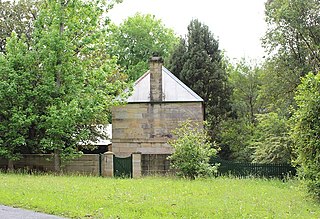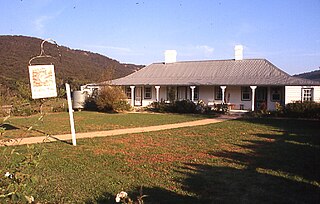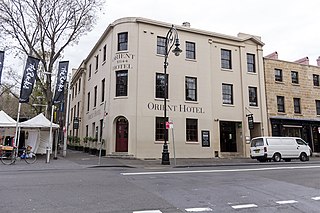
Windsor railway station is a heritage-listed railway station located on the Richmond line, serving the Sydney suburb of Windsor, in New South Wales, Australia. It is served by Sydney Trains' T1 Western and T5 Cumberland line services. It was added to the New South Wales State Heritage Register on 2 April 1999.

The Dawes Point Battery remains is a heritage-listed former artillery fortification and now visitor attraction located adjacent to the southern pylon of the Sydney Harbour Bridge at Hickson Road in inner city Sydney, on the boundary between Dawes Point and The Rocks in the City of Sydney local government area of New South Wales, Australia. It was built and modified from 1791 to 1925 by Lieutenant William Dawes, Robert Ross, Francis Greenway, and George Barney. The property is owned by Property NSW, an agency of the Government of New South Wales. It was added to the New South Wales State Heritage Register on 10 May 2002.

Loder House is a heritage-listed residence at 126 George Street, Windsor, City of Hawkesbury, New South Wales, Australia. It was built in 1834. It has been used at times for various other purposes: as a bank, multiple restaurants, a guesthouse and a bookshop. It was added to the New South Wales State Heritage Register on 2 April 1999.

Merriville House & Gardens is a heritage-listed residence at Eire Way, Kellyville Ridge, New South Wales, Australia. It was built from 1817 to 1855. It is also known as Hambledon Cottage, Hambledon and Maryville. It was added to the New South Wales State Heritage Register on 2 April 1999.

The Royal Oak Inn is a heritage-listed hotel located on the corner of Windsor Road and Commercial Road, in Rouse Hill in The Hills Shire local government area of New South Wales, Australia. It was built in 1829. It has also been known as the Queens Arms Inn, and is currently known as the Fiddler Hotel. The property is privately owned and was added to the New South Wales State Heritage Register on 2 April 1999.
Parramatta Sand Body Conservation Area and Military Barracks Site is a heritage-listed archaeological site relating to both Aboriginal and European occupation at George and Harris Streets, Harris Park, City of Parramatta, Sydney, New South Wales, Australia. It was added to the New South Wales State Heritage Register on 8 July 2011.

Glen Innes Post and Telegraph Office is a heritage-listed post office at Grey Street, Glen Innes, Glen Innes Severn, New South Wales, Australia. It was designed by NSW Government Architect's Office under Walter Liberty Vernon. and built from 1895 to 1896 by Sandbrook Brothers. The property is owned by Australia Post. It was added to the New South Wales State Heritage Register on 23 June 2000. It was added to the Australian Commonwealth Heritage List on 8 November 2011.

Macquarie Arms Hotel is a heritage-listed hotel at Thompson Square in Windsor, New South Wales, Australia. It is also known as the Royal Hotel. It was added to the New South Wales State Heritage Register on 2 April 1999.

Goldfinders Inn is a heritage-listed former inn, guesthouse, general store and post office and now residence at 164 Old Bells Line of Road, Kurrajong, City of Hawkesbury, New South Wales, Australia. It was built from 1809 to 1830 by John Lamrock. It is also known as Gold Finders Rest, Kurrajong General Store and Kurrajong Post Office. It was added to the New South Wales State Heritage Register on 21 October 2016.

Collits' Inn is a heritage-listed former inn and now functions, accommodation and restaurant at Hartley Vale Road, Hartley Vale in the Central West region of New South Wales, Australia. It was designed by Pierce Collits and built in 1823. It is also known as Collitts Inn and Golden Fleece Inn. It was added to the New South Wales State Heritage Register on 2 April 1999.

Richmond Post Office is a heritage-listed former post office at 286 Windsor Street, Richmond, City of Hawkesbury, New South Wales, Australia. It was designed by Colonial Architect James Barnet and built from 1875 to 1888. The original building was built by a Mr. Johnson, with the second-story addition in 1888 added by Samuel Bought. It is also known as Richmond Telegraph and Post Office. It was added to the New South Wales State Heritage Register on 23 June 2000.

Thompson Square Conservation Area is a heritage-listed precinct centred around Thompson Square in Windsor, City of Hawkesbury, New South Wales, Australia. It was added to the New South Wales State Heritage Register on 2 April 1999.
Cox's Cottage is a heritage-listed pasturing land and residence located at 2 St Thomas Road in the western Sydney suburb of Mulgoa in the City of Penrith local government area of New South Wales, Australia. It was built from 1810 to 1811 by James King. It is also known as Mulgoa Cottage; The Cottage, Coxs Cottage, and was formally known as Fern Hill and Estate of Mulgoa before the new house was built. The property remains privately owned and is the oldest house in Australia still in residence. It was added to the New South Wales State Heritage Register on 2 April 1999.

St Matthew's Anglican Church is a heritage-listed Anglican church building located at Moses Street, Windsor, City of Hawkesbury, New South Wales, Australia. It was designed by Francis Greenway and built from 1817 by convict labour. The property is owned by the Anglican Church Property Trust. It was added to the New South Wales State Heritage Register on 2 April 1999.

Court House Hotel is a heritage-listed former hotel and now residence at 37–39 North Street, Windsor, City of Hawkesbury, New South Wales, Australia. It was added to the New South Wales State Heritage Register on 2 April 1999. It is often associated with the adjoining North Street residences, some of which shared ownership with the hotel at various times.

The Russell Hotel is a heritage-listed hotel located at 143 George Street, in the inner city Sydney suburb of The Rocks, Australia. It was built in 1887. It operated as the Port Jackson Hotel until being delicensed in 1923, after which time a new Port Jackson Hotel was built further along George Street. In 1933, it became the Russell Private Hotel, providing accommodation from the upper floors. The ground floor has been leased for various uses since the original delicensing, initially as a cafe for several decades and most recently as a restaurant and bar. It is owned by Property NSW.

The Orient Hotel is a heritage-listed pub located at 87–89 George Street, in the inner city Sydney suburb of The Rocks in the City of Sydney local government area of New South Wales, Australia. It was built from 1843 to 1844. The property is owned by Property NSW, an agency of the Government of New South Wales. It was added to the New South Wales State Heritage Register on 10 May 2002.

The Cumberland Street Archaeological Site is a heritage-listed archaeological site located at 106–128 Cumberland Street in the inner-city Sydney suburb of The Rocks in the City of Sydney local government area of New South Wales, Australia. The site includes the remains of early convict-era housing dating as far back as 1795, and a modern youth hostel has been built elevated over the remnants. It is also known as The Big Dig Site,Sydney YHA, and theBig Dig Education Centre. The property is owned by Property NSW, an agency of the Government of New South Wales, and it was added to the New South Wales State Heritage Register on 17 December 2010.

St Peter's Anglican Church is a heritage-listed Anglican church and associated Sunday school, rectory, and cemetery at 384 Windsor Street, Richmond, City of Hawkesbury, New South Wales, Australia. It was designed by Francis Clarke and Edmund Blacket and built from 1836 to 1841 by James Atkinson (church). It is also known as St Peter's Anglican Church Group, St Peter's Church Group, Church, Rectory, Church Yard, Cemetery and Stables. It was added to the New South Wales State Heritage Register on 16 August 2019; and on the City of Hawkesbury local government heritage register, and listed on the New South Wales Heritage Database on 12 September 2012.

Hadley Park is a heritage-listed former Aboriginal land, farm, dairy and gravel quarry and now unused building at 14-278 Old Castlereagh Road, Castlereagh, City of Penrith, New South Wales, Australia. It was built from 1803 to 1812. It was added to the New South Wales State Heritage Register on 20 April 2018.



















